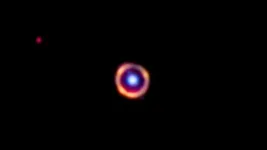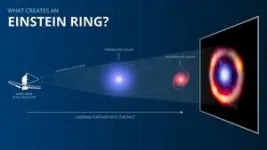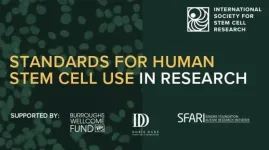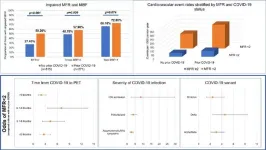(Press-News.org) An international team of astronomers has detected complex organic molecules in the most distant galaxy to date using NASA’s James Webb Space Telescope.
The discovery of the molecules, which are familiar on Earth in smoke, soot and smog, demonstrates the power of Webb to help understand the complex chemistry that goes hand-in-hand with the birth of new stars even in the earliest periods of the universe’s history. At least for galaxies, the new findings cast doubt on the old adage that where there’s smoke, there’s fire.
Using the Webb telescope, Texas A&M University astronomer Justin Spilker and collaborators found the organic molecules in a galaxy more than 12 billion light-years away. Because of its extreme distance, the light detected by the astronomers began its journey when the universe was less than 1.5 billion years old — about 10% of its current age. The galaxy was first discovered by the National Science Foundation’s South Pole Telescope in 2013 and has since been studied by many observatories, including the radio telescope ALMA and the Hubble Space Telescope.
Spilker notes the discovery, reported this week in the journal Nature, was made possible through the combined powers of Webb and fate, with a little help from a phenomenon called gravitational lensing. Lensing, originally predicted by Albert Einstein’s theory of relativity, happens when two galaxies are almost perfectly aligned from our point of view on Earth. The light from the background galaxy is stretched and magnified by the foreground galaxy into a ring-like shape, known as an Einstein ring.
“By combining Webb’s amazing capabilities with a natural ‘cosmic magnifying glass,’ we were able to see even more detail than we otherwise could,” said Spilker, an assistant professor in the Texas A&M Department of Physics and Astronomy and a member of the George P. and Cynthia Woods Mitchell Institute for Fundamental Physics and Astronomy. “That level of magnification is actually what made us interested in looking at this galaxy with Webb in the first place, because it really lets us see all the rich details of what makes up a galaxy in the early universe that we could never do otherwise.”
The data from Webb found the telltale signature of large organic molecules akin to smog and smoke —building blocks of the same cancer-causing hydrocarbon emissions on Earth that are key contributors to atmospheric pollution. However, Spilker says the implications of galactic smoke signals are much less disastrous for their cosmic ecosystems.
“These big molecules are actually pretty common in space,” Spilker explained. “Astronomers used to think they were a good sign that new stars were forming. Anywhere you saw these molecules, baby stars were also right there blazing away.”
The new results from Webb show that this idea might not exactly ring true in the early universe, according to Spilker.
“Thanks to the high-definition images from Webb, we found a lot of regions with smoke but no star formation, and others with new stars forming but no smoke,” Spilker added.
University of Illinois Urbana-Champaign graduate student Kedar Phadke, who led the technical development of the team’s Webb observations, noted that astronomers are using Webb to make connections across the vastness of space with unprecedented potential.
“Discoveries like this are precisely what Webb was built to do: understand the earliest stages of the universe in new and exciting ways,” Phadke said. “It’s amazing that we can identify molecules billions of light-years away that we’re familiar with here on Earth, even if they show up in ways we don’t like, like smog and smoke. It’s also a powerful statement about the amazing capabilities of Webb that we’ve never had before.”
The team’s leadership also includes NASA’s Goddard Space Flight Center astronomer Jane Rigby, University of Illinois professor Joaquin Vieira and dozens of astronomers around the world.
The discovery is Webb’s first detection of complex molecules in the early universe — a milestone moment that Spilker sees as a beginning rather than an end.
“These are early days for the Webb Telescope, so astronomers are excited to see all the new things it can do for us,” Spilker said. “Detecting smoke in a galaxy early in the history of the universe? Webb makes this look easy. Now that we’ve shown this is possible for the first time, we’re looking forward to trying to understand whether it’s really true that where there’s smoke, there’s fire. Maybe we’ll even be able to find galaxies that are so young that complex molecules like these haven’t had time to form in the vacuum of space yet, so galaxies are all fire and no smoke. The only way to know for sure is to look at more galaxies, hopefully even further away than this one.”
The team’s paper, “Spatial variations in aromatic hydrocarbon emission in a dust-rich galaxy,” can be viewed online along with related figures and acknowledgements.
JWST is operated by the Space Telescope Science Institute under the management of the Association of Universities for Research in Astronomy under NASA contract NAS 5-03127. The South Pole Telescope is supported by the National Science Foundation, the Department of Energy and the United States Antarctic Program.
END
Webb telescope detects universe’s most distant organic molecules
Texas A&M astronomer Justin Spilker and collaborators have found complex organic molecules in a galaxy more than 12 billion light-years away from Earth.
2023-06-06
ELSE PRESS RELEASES FROM THIS DATE:
Breastfeeding for longer may be linked to better exam results in later life
2023-06-06
Children who are breastfed for longer appear to be more likely to gain slightly better results in their school GSCEs at age 16 compared with non-breastfed children, suggests a study published online in the journal Archives of Disease in Childhood.
The evidence of improved educational outcomes is still apparent even when various factors are taken into account such as people’s socio-economic status and their parents’ intelligence.
Previous studies have suggested that children breastfed for longer have improved educational outcomes later in life. However these are relatively scarce, and ...
Close contact intervention between a mother and her premature baby may reduce risk of mortality by almost a third
2023-06-06
A method of care involving skin-to-skin contact between a mother and her prematurely born or low birth weight baby appears to impact the child’s chances of survival significantly, suggests a study published online in the journal BMJ Global Health.
Starting the intervention within 24 hours of birth and carrying it out for at least eight hours a day both appear to make the approach even more effective in reducing mortality and infection, researchers found.
The method of care known as ‘Kangaroo mother care’ (KMC) involves an infant being carried, usually by the mother, in a sling with skin-to-skin contact ...
Defibrillators used in just 10 per cent of out of hospital cardiac arrests - study shows
2023-06-06
Defibrillators are being used in just one in ten cardiac arrests where the lifesaving devices are available, according to new research presented at the British Cardiovascular Society Conference in Manchester.
The research drew upon data from the East of England Ambulance Service and The Circuit, the national defibrillator network developed by the British Heart Foundation (BHF). The Circuit maps the location of defibrillators across the whole of the UK, so that emergency services can direct bystanders to the nearest defibrillator in the event of ...
Virtual blood vessel technology could improve heart disease care
2023-06-06
Patients with heart disease could benefit from less extensive interventions thanks to cutting-edge technology that creates 3D computer models of blood flow through the heart's arteries, according to research presented at the British Cardiovascular Society in Manchester.
When the research team trialled the VIRTUHeartTM technology with doctors treating heart attack patients, they found that using it would have changed the treatment of more than 20 per cent of patients. In many cases, it would have led to fewer patients undergoing an invasive procedure such ...
The ISSCR releases global standards to enhance rigor and reproducibility of stem cell research
2023-06-06
The International Society for Stem Cell Research (ISSCR) today released the ISSCR Standards for Human Stem Cell Use in Research, an international collaboration aimed at enhancing rigor in preclinical research and ultimately strengthening the pipeline of therapies for patients.
“This nearly two-year initiative is groundbreaking for the global stem cell research community,” said Haifan Lin, ISSCR president. “The international standards will make a big difference in the quality of science that is performed and published worldwide.”
The ISSCR is the preeminent international stem cell research society with a reputation ...
Childhood maltreatment predicts adult emotional difficulties
2023-06-06
Have you ever wanted to convey a feeling but just couldn’t find the right words? Millions of people struggle with a personality trait known as alexithymia, which means “no words for feelings.” Individuals with alexithymia have difficulty identifying and describing their emotions. This trait can harm their social and intimate relationships. They are likely to miss social cues and thus fail to recognize or understand the feelings of others. Past research has suggested that a history of child maltreatment could play a role in developing adult alexithymia.
A new meta-analysis published this month in Psychological Bulletin, led by Stanford ...
New analysis shows COVID variant and severity of illness influence cardiac dysfunction, a key indicator of long COVID
2023-06-06
Patients infected with beta and delta COVID-19 variants, and those who required hospital stays for COVID-19 infection, were more likely to experience heart issues associated with long COVID, according to a recent Houston Methodist study published in the European Heart Journal – Cardiovascular Imaging. Patients recovering from the omicron variant were least likely to have microvascular involvement.
“This new data expands our understanding of myocardial flow reserve as an important prognostic marker in general and specifically in COVID-19,” said Mouaz Al-Mallah, M.D., corresponding author of the study and director of cardiovascular ...
Renowned sociologist and Black Voices Quintet set to dazzle at HDR UK’s Black Internship Programme Opening Ceremony 2023
2023-06-05
Contact: Clare Leahy clare.leahy@hdruk.ac.uk 07748016062
Event registration for press: https://bit.ly/45rIQBr
Health Data Research UK (HDR UK) is launching its Health Data Science Black Internship Programme for the third year running at its Opening Ceremony on Wednesday 21 June from 12-5pm at the Curzon Building in Birmingham City University.
The programme, run in partnership with the UK Health Data Research Alliance and 10,000 Black Interns is helping to tackle the underrepresentation of Black people within science, technology, engineering, and mathematics ...
Sleep societies announce 2023 Diversity, Equity and Inclusion Leadership Award recipient
2023-06-05
DARIEN, IL – Sleep researcher Dayna A. Johnson is the recipient of the 2023 Diversity, Equity and Inclusion Leadership Award from the Associated Professional Sleep Societies, a joint initiative of the American Academy of Sleep Medicine and the Sleep Research Society.
The award recognizes individuals who have made significant contributions to sleep medicine or sleep and circadian science through their work to increase the diversity, equity, and inclusion of sleep medicine providers, or to develop educational programs, research, or clinical work aimed at reducing disparities. The award presentation occurred Monday, June 5, during the plenary session of the ...
NPS professor and student develop patented self-sealing fuel line
2023-06-05
Patents from the Naval Postgraduate School (NPS) are a measure of novel inventions, but each also tells a story of a relevant idea with warfighting impact. NPS Department of Physics Associate Professor Ray Gamache and his former graduate student, NPS alumnus U.S. Marine Corps Maj. Chris Phifer, developed and recently patented a new polymer-based, self-sealing fuel line capable of withstanding a .50 caliber bullet without losing so much as a single drop.
“We’re not just a physics department, we’re the applied physics department,” Gamache said. “While ...
LAST 30 PRESS RELEASES:
UVA’s Jundong Li wins ICDM’S 2025 Tao Li Award for data mining, machine learning
UVA’s low-power, high-performance computer power player Mircea Stan earns National Academy of Inventors fellowship
Not playing by the rules: USU researcher explores filamentous algae dynamics in rivers
Do our body clocks influence our risk of dementia?
Anthropologists offer new evidence of bipedalism in long-debated fossil discovery
Safer receipt paper from wood
Dosage-sensitive genes suggest no whole-genome duplications in ancestral angiosperm
First ancient human herpesvirus genomes document their deep history with humans
Why Some Bacteria Survive Antibiotics and How to Stop Them - New study reveals that bacteria can survive antibiotic treatment through two fundamentally different “shutdown modes”
UCLA study links scar healing to dangerous placenta condition
CHANGE-seq-BE finds off-target changes in the genome from base editors
The Journal of Nuclear Medicine Ahead-of-Print Tip Sheet: January 2, 2026
Delayed or absent first dose of measles, mumps, and rubella vaccination
Trends in US preterm birth rates by household income and race and ethnicity
Study identifies potential biomarker linked to progression and brain inflammation in multiple sclerosis
Many mothers in Norway do not show up for postnatal check-ups
Researchers want to find out why quick clay is so unstable
Superradiant spins show teamwork at the quantum scale
Cleveland Clinic Research links tumor bacteria to immunotherapy resistance in head and neck cancer
First Editorial of 2026: Resisting AI slop
Joint ground- and space-based observations reveal Saturn-mass rogue planet
Inheritable genetic variant offers protection against blood cancer risk and progression
Pigs settled Pacific islands alongside early human voyagers
A Coral reef’s daily pulse reshapes microbes in surrounding waters
EAST Tokamak experiments exceed plasma density limit, offering new approach to fusion ignition
Groundbreaking discovery reveals Africa’s oldest cremation pyre and complex ritual practices
First breathing ‘lung-on-chip’ developed using genetically identical cells
How people moved pigs across the Pacific
Interaction of climate change and human activity and its impact on plant diversity in Qinghai-Tibet plateau
From addressing uncertainty to national strategy: an interpretation of Professor Lim Siong Guan’s views
[Press-News.org] Webb telescope detects universe’s most distant organic moleculesTexas A&M astronomer Justin Spilker and collaborators have found complex organic molecules in a galaxy more than 12 billion light-years away from Earth.






